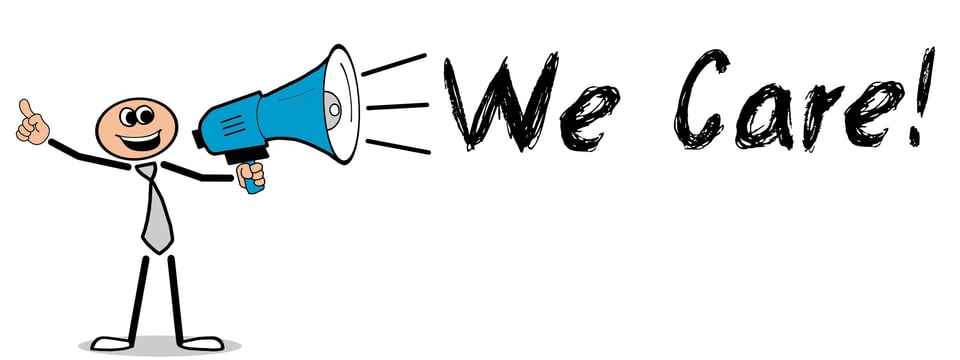Accessibility Statements: The good, the bad, and the ugly

Let’s start with the basic premise that not all accessibility statements are created equally.
If you work in digital accessibility, you've probably seen the full spectrum of accessibility statements. These range from non-existent to misleading to well-written and accurate. They may look similar on the surface, but the intent and effort behind them can vary dramatically. Here’s a breakdown of the most common types.
1. No Accessibility Statement at All
Silence speaks volumes. When a site has no accessibility statement, it usually means one of three things:
The website owner knows nothing about accessibility
Someone has thought about accessibility, yet deliberately chosen to say nothing
Neither sends a good message. Without a statement, users have no information on what barriers to expect, whether feedback is welcome, or how to report issues. For organizations covered under laws like the ADA, AODA, or EAA, the absence of a statement could quickly become a costly legal liability.
2. Unedited Out-of-the-Box Statement
These are easy to spot. They often appear in small business sites built on platforms like Wix or WordPress and contain phrases like:
"We are committed to making our website accessible to everyone. Our website follows the WCAG 2.1 guidelines..."
If the company hasn’t updated anything beyond the placeholder language, that’s a red flag. It usually means:
No actual accessibility testing happened
No one read the statement, much less customized it
From the perspective of the disabled user, there is no connection between the statement and the site’s experience
Out-of-the-box accessibility statements are performative and misleading. They call an organization’s entire inclusion strategy into question. Remember, just like ADA cookie-cutter litigation, if it smells like copy and paste, it probably is.
3. Vague or Aspirational Customized Statements
These are the accessibility statements that only address accessibility motherhood and apple pie. They gush over how "we're working on accessibility," “we’re all about inclusion,” or "we strive to be accessible.” “We have a disability ERG,” some shout. Some include pictures of disabled employees or customers. Some even go so far as to talk about the automated tools they use or the empathy sessions the organization has run.
Without technical details and standards, aspirational statements are clear evidence that the organization was grasping at straws and thought to throw everything that might make people feel good in there, and shift focus away from the fact that the organization isn’t doing much..
Aspirational accessibility statements are the cotton candy of the software field; garbage without nutrition. They sound nice, but are vague to the point of being useless. Without dates, specific actions, or documented progress, aspirational accessibility statements provide no meaningful assurance to disabled users about whether their assistive technology will function correctly enough on the website to provide equal access. Most importantly, many companies feel putting out an accessibility statement is ALL they are obligated to do.
Accessibility is not a future state. Either software conforms to WCAG, or it doesn’t. “Striving to be accessible” means absolutely f*** all to an assistive technology user who needs to complete an urgent transaction today. It is accessibility theater, which is built for optics and not outcomes.
4. Transparent and Actionable Statements
This is what good looks like. A strong accessibility statement includes:
What guidelines does the site aim to follow (e.g., WCAG 2.2 AA)
What testing was done, when, and how often? For bonus points, document whether the testers had disabilities or the testing was done by an outside agency.
What assistive technology was used
What environments were tested
Known limitations and plans for remediation
Contact information for reporting issues
A timeline for updates or repeat audits
Optional: A plain language version
Contact information for reporting issues.
Transparent and actionable accessibility statements reflect genuine effort. They acknowledge that accessibility is a process, not a checkbox. And they prioritize users over legal disclaimers.
Why This Matters
Accessibility statements aren’t mere formalities. They are a contractual promise to users that face digital barriers every day that will be piece of evidence number one in any demand letter or piece of litigation an organization ever receives. The words used in the accessibility statement strongly signal how seriously an organization takes legal, ethical, and human responsibilities for its users.
If you are responsible for your organization’s accessibility efforts, audit your own statement. Ask disabled users for feedback. Keep it up to date. Be specific. Be honest. Set up an email box to receive and monitor accessibility-specific complaints. Most importantly, ensure the statement reflects real actions and achievements, not aspirations. If you don’t like what’s in your statement, then the conversation needs to pivot internally to “what more can we do?”
Access delayed is access denied. When a protected class member, such as a potential customer with a disability, is denied access, the risk of litigation and bad publicity is always there. Don’t make it worse by talking about things in your accessibility statement that you aren’t doing.
Add a comment: